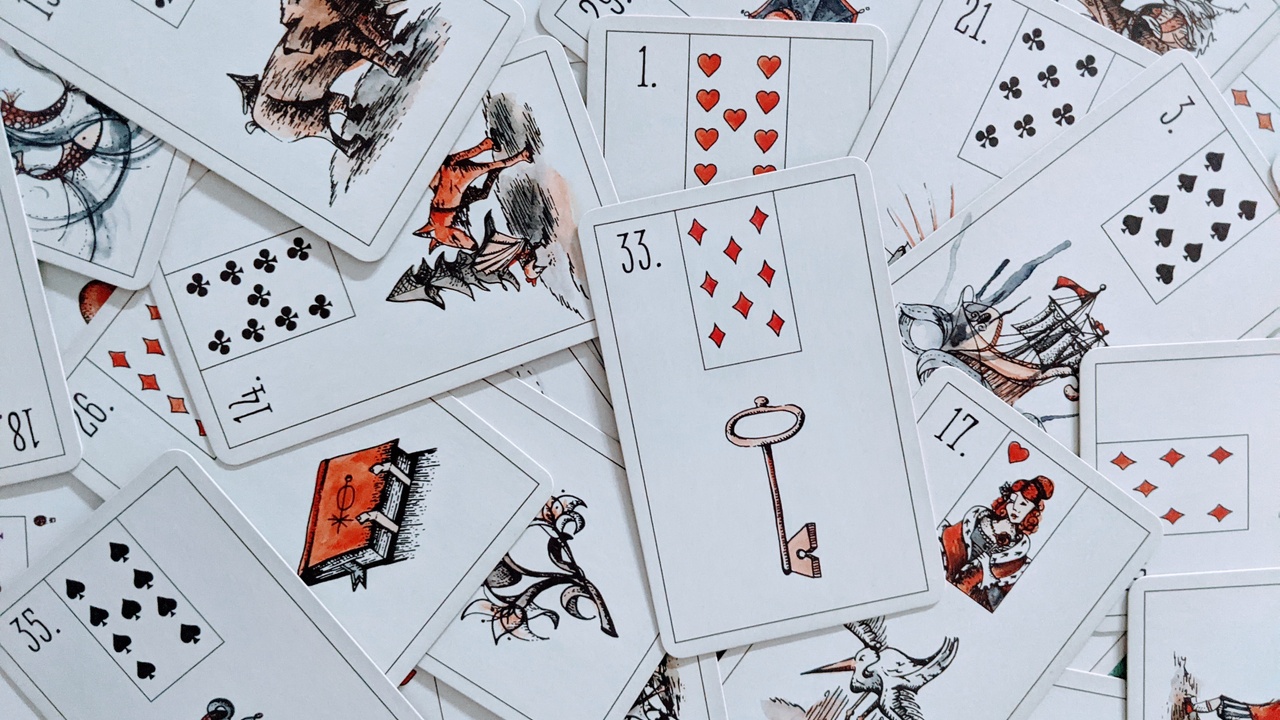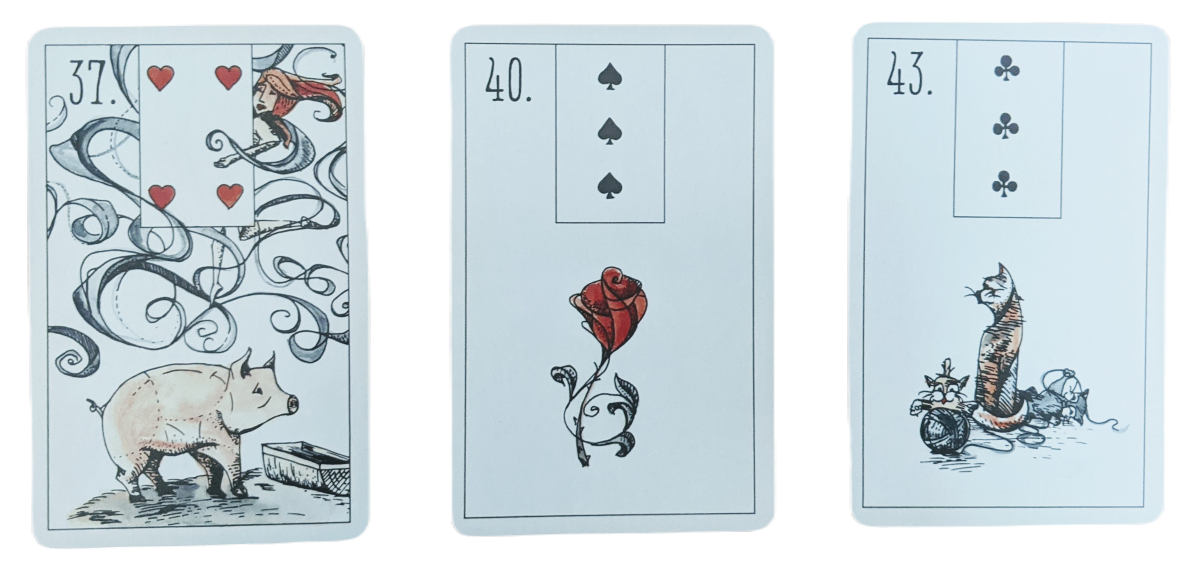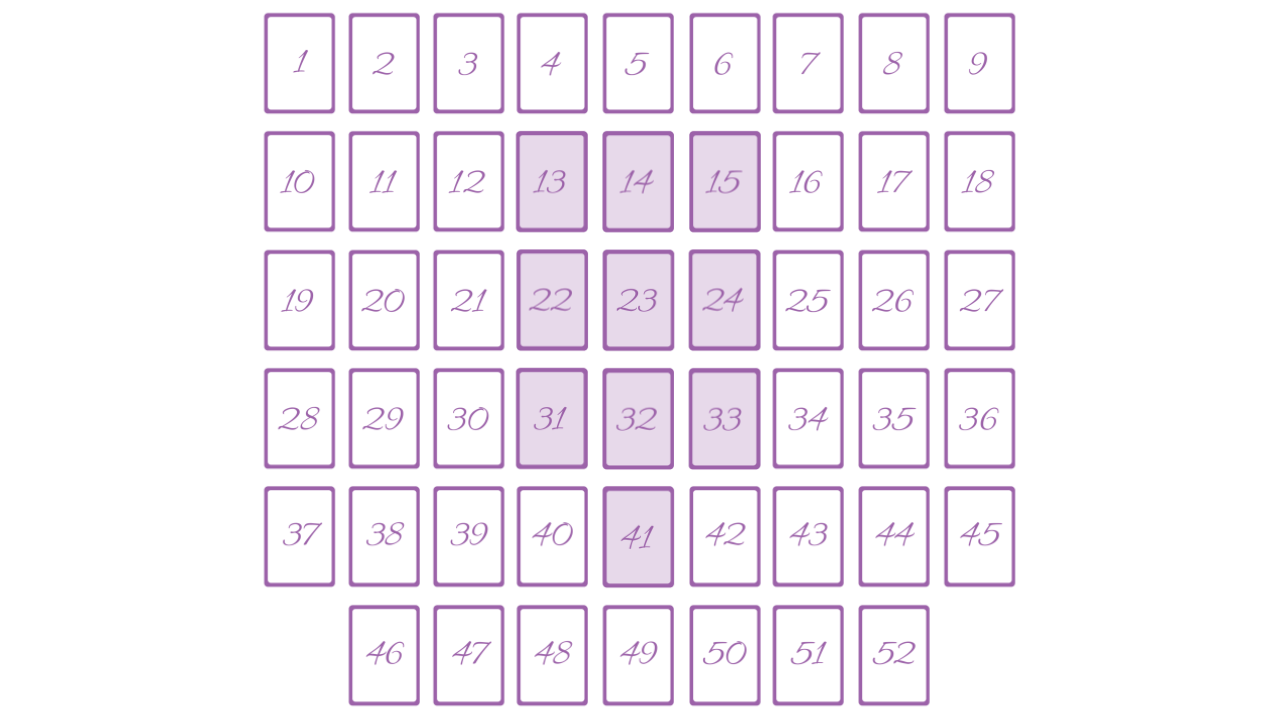
RYAN EDWARDS'S MAYBE LENORMAND
NOTE. In this post, “Guidebook” refers to the booklet accompanying the Maybe Lenormand deck.
Ryan Edward’s Maybe Lenormand is one of my favorite decks.
It’s really his card designs and good humor that I find catchy, and he has a simple, straightforward, and yet witty approach to working with the cards.
Let’s explore Edward’s deck.
DECK DESIGN & UNIQUE FEATURES
The Maybe Lenormand is published by U.S. Games Systems, Inc., which is well-known for producing Tarot and Lenormand decks. So the cards are sturdy and durable, and the print is high quality with little bleeding over time.
The unique feature of his deck is the additional 16 cards that he adds to the original 36 to ‘complete’ Lenormand’s Petit Jeu to a regular 52-card deck.
The card designs are minimalistic with a bit of color, mainly black, white, and shades of gray and red.
The card number is at the top left, and the pip inset is at the top center. The main illustration of the card is below the pip. And a thin black line frames the card.
Each card has only these three main elements - number, pip, and main symbol or illustration - set against a plain white background.
The cards are crisp, clear, and without added designs or colors that often clutter a Lenormand card - especially when it’s small in size. So it’s easy to look at the cards. This is my personal preference with card designs.
The main card illustration drawings have a cartoonish and playful character. This is where we see Edward’s sense of humor with the deck, which I feel is very welcome for divination.
It reminds me of Dennis Fairchild's Tarot cards and books. His illustrator, Julie Pashkis, is in my opinion, one of the loveliest illustrators I have come across.
I love just about every card design in Edward’s the deck, but the Anchor, Clouds, Fish, Sun, and Tower are among my favorites.

CARD MEANINGS AND CARD COMBINATIONS
Edward’s interpretation of cards 1-36 is succinct and to the point. For each card, he offers a general meaning, its characteristics as a person, and a few keywords.
He captures their essence clearly, and so his dictionary is helpful and handy, especially for those just starting out with Lenormand.
At times, he offers interesting, fun, and insightful interpretations.
For example, he suggests that the Anchor can represent tattooed people, because the Anchor often symbolizes sailors who are typically tattooed with anchors and other symbols related to the sea and sailing. I love it!
This is a good example of Edward’s good humor and creativity with the cards.
I appreciate how he suggests that the Ship can represent longing through its association with distance and travel. This angle immediately resonated with me, and I quickly found that it made sense with some interpretations of the Ship in my readings.
Edward’s approach with the card meanings is focused and straightforward. But I can’t say that I feel the same way about his additional 16 cards. You might know by now that I’m a Lenormand purist, and I like to keep the Petit Jeu as it is.
Lenormand’s Petit Jeu is said to come from the Piquet deck, which is just like a regular playing card deck, except it has only 36 cards because it doesn’t have pips 2 through 5.
So Edward’s deck is on a mission to up the Petit Jeu to a full 52-card Lenormand. Not only does he create an additional 16 emblems for the extra cards, but he also assigns their pips.
He makes a case for adding these cards by suggesting that:
“These extra cards don’t ‘muddy up’ the meaning. Many help carry the secondary focus of other cards in the spread, so once you are using all 52, each card becomes more precise, and thus the readings provide more clarity.” (Maybe Lenormand Fortune Telling Guidebook, p. 52)
I understand his point completely, but I would argue that precision comes from reading Lenormand’s cards in combinations, which is the cornerstone of the Lenormand method.
Edward himself makes this point clearly, at least in the context of the Grand Tableau:
“Its readings are that of relationships; left right above or below, where cards intersect or disperse, where they meet near or far, or if they are surrounded by negative or positive cards.” (Maybe Lenormand Fortune Telling Guidebook, p. 3)
Still, Edward’s mission is a fun exercise and certainly worth musing over.
I won’t spoil the fun by listing every card he adds to the deck, but I want to illustrate how some of his suggestions are fulfilled by existing cards in the 36-card Lenormand.
Card 37, Pig: Opulence. This card is about wealth, luxury, status, fine taste, and the like.
Well, that can be the Fish. Especially in combination with positive cards, like the Sun, and ‘big’ cards like the Bear. So I’m not so sure this card adds precision we don’t already have in the Petit Jeu.
Card 40, Rose: Allure. Edward suggests the Rose is about romance, seduction, art, tenderness, and similarly soft and creative energies. With the Letter, the pair can refer to poetry. And with the Birds, possibly music.
These are lovely ways to describe the Moon! I think I’d like to adopt his combinations, just substituting the Rose for the Moon. Again, I find him quite creative and really in tune with the card meanings and nuances, but, as with the Pig, I feel the Rose can be expressed by cards in the 36 deck.
Card 43, Cats: Self-Centered. Edward writes: “The Cats are what the Dog is not.” (Guidebook, p. 59). I love his sense of humor! The Cats card represents fickleness, flattery, greed, and impatience.
I’m not so sure how impatient cats are - they’re very good hunters - but these ideas describe the Fox rather well. And some Lenormand authors will actually use the Fox to identify a pet cat, as opposed to the Dog which obviously represents a pet dog. So this is another example of how I don’t feel the extra cards add value to the deck.

I encourage you to explore his extra set of cards 37 to 52, and see for yourself if and how they add value to the Lenormand deck.
In all cases, expanding Lenormand’s deck to 52 cards is without a doubt a fun and creative exercise. Rana George also adds cards to the deck, but only four. You yourself might like to try your hand at it. Think about what in life isn’t or can’t be represented by Lenormand’s 36 cards and combinations.
In my opinion, the reason why Lenormand is so down to earth and “in your face”, is precisely because it’s easy to create meaning from its cards and combinations.
LAYOUTS AND INTERPRETATION TECHNIQUES
In just a few pages in his small Guidebook, Edward manages to cover the Grand Tableau, three-card lines, and five-card lines.
With the Grand Tableau, Edward focuses on the near and far technique, meaning which cards are close to the significator and which ones are far, and he also looks at the interplay between the Man and Woman.
I’m sure there’s plenty more he reads in a Tableau, but there’s only so much that can be covered in a Guidebook that accompanies a deck.
Still, his Tableau suggestions are a great place to start training that Tableau muscle, and he explains them in his accessible style.
Because Edward ups the deck to 52 cards, he also offers the Très Grand Tableau. Très means ‘very’ in French, so this translates into the Very Big Tableau. I’m all smiles.

This 52-card Tableau is laid out in exactly the same way as a Piquet Tableau, except it has 5 rows of 9 cards, plus one row of 7 cards as the bottom line.
Edward suggests that an advantage of this Tableau is its heart: the Portrait around card 23, plus card 41. As in a regular Grand Tableau, the heart tells of the “heart of the matter.”
Try your hand at this super big spread! Assuming you have 52 cards.
With three-card lines, Edward appeals to the “grammatical” style that many authors associate with Lenormand. He suggests that a three-card line “should give you a short, simple answer with a subject, modifier, and some action or outcome.” (Guidebook, p. 7)
The concept of a modifier is often used by Lenormand authors to describe the idea that one card qualifies another - depending on the order of the cards.
For example, the Letter and Sun indicate that the news is happy. The Letter and Whip suggest the news is not so good. The Sun and Whip in these pairs qualify the Letter, like an adjective qualifies a noun.
I feel Edward’s wit and creativity really come through with the examples he gives for three- and five-card readings.
For example, Example 2 of three-card lines asks: “A querent lost her wallet, where is it?”
Book + Rider + Park
The Park is his name for the Garden. He takes this triplet to suggest “In her backpack (Book + Rider) in the back yard (Park).” (Guidebook, p. 8).
I think it’s really clever how he took the Rider to represent the word “back” - as in horseback - and so the combinations with the Book and Garden make perfect sense.
It would have been really nice to know if his interpretation predicted correctly!
Another illustration of his skill is a five-card daily reading for a woman who works 9 to 5.
Woman + Park + Letter + Ring + Child
These cards suggest that she’s busy with meetings today, and when she leaves work, she will be with her child.
The way Edward breaks up a five-card line for a daily reading is very practical, and you might like to try your hand at it as you learn to read the cards in combinations and as you practice going beyond three cards.
Edward suggests that cards 1-3 cover the daytime period of the day, and cards 3-5 cover the evening (Guidebook, p. 11).
This resonates well with me because I often take the cards toward the left of a line to represent the earlier phases of a storyline, and the cards toward the right to represent the later stages.
Edward prefers the five-card over the three-card line for a daily reading because three cards can be “very mundane [...] and often [point] to a specific moment or event. Without knowing if this is during your workday, at school, or in the evening, it can be hard to decipher. For this reason, I like to use five cards to help establish a time frame.” (p. 10)
It’s true that with Lenormand, short lines are limited. Titania Hardie goes for even longer and suggests a seven-card line for daily readings.
QUOTABLE QUOTES
Unfortunately, it doesn’t appear like Edward has written many books about Lenormand - or just in general. He does have a Tarot deck (the Playing Marseille), but it is not available as of the writing of this post. Please get in touch with me if you know where copies of it are available, I would appreciate it.
Still, from his small Maybe Lenormand Guidebook, I found a memorable quote that I care to share here in addition to the ones I noted above.
About the Clouds card, which he calls Thundercloud and associates with the keyword Turbulence - good word - Edward notes:
“The King of Clubs is a shady figure. He uses his wife, the Serpent, to twist the truth, and his son, the Birch, to instigate an argument on his behalf. Beware this man on all fronts.” (Guidebook, p. 20)
It’s another clever way of telling a story with the cards. Here, he connects rather well the energy of the three court cards from the suit of clubs.
If you read my Card Combinations Master or enrolled in the MLCC or Certification Program, you would have discovered that each Lenormand suit has its specific energy and dynamics.
Telling a story to connect them like Edward does with the club courts can really bring them to life. You might like to try this as you set out to learn the card meanings and combinations. They don’t have to be from the same suit.
He is not the only Lenormand author to do this. The gifted Caitlin Matthews also tells a story with the cards, and indeed, with the whole deck.
NOTE ABOUT THIS POST This blog post and/or video are produced in good faith to promote the author’s work and bring together the Lenormand community. If the author(s) or his/her representative(s) has any concern with the information presented, kindly write to Layla, the Lenormand Reader. Layla, the Lenormand Reader, reserves all rights.

Want To Become A Lenormand Reader?
Lenormand Reader’s Certification Program is the only one of its kind, in size and in depth, to help you master the amazing Lenormand deck. This Program is filled with knowledge and practice accumulated through 20+ years of study and practice. It is organized into a real body of knowledge and delivered with best in class, online, on-demand video. Join the waitlist so you secure your spot when registration opens.
Join Lenormand Reader’s Certification Program
